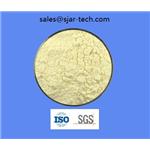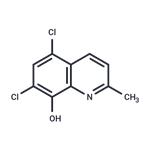- Chlorquinaldol
-

- $0.00 / 1g
-
2025-01-13
- CAS:72-80-0
- Min. Order: 1g
- Purity: More Than 99%
- Supply Ability: 100kg/Month
- Chlorquinaldol
-

- $29.00 / 1mL
-
2024-11-19
- CAS:72-80-0
- Min. Order:
- Purity: 99.93%
- Supply Ability: 10g
|
| | 5,7-Dichloro-8-hydroxyquinaldine Basic information |
| | 5,7-Dichloro-8-hydroxyquinaldine Chemical Properties |
| Melting point | 108-112 °C (dec.)(lit.) | | Boiling point | 350.7±37.0 °C(Predicted) | | density | 1.3126 (rough estimate) | | refractive index | 1.5500 (estimate) | | storage temp. | Keep in dark place,Sealed in dry,Room Temperature | | solubility | DMSO, Methaol (Slightly) | | form | Solid | | pka | 2.47±0.30(Predicted) | | color | Dark Beige to Very Dark Beige | | Water Solubility | Insoluble | | Merck | 13,2209 | | BRN | 156683 | | CAS DataBase Reference | 72-80-0(CAS DataBase Reference) | | NIST Chemistry Reference | Chlorquinaldol(72-80-0) |
| | 5,7-Dichloro-8-hydroxyquinaldine Usage And Synthesis |
| Chemical Properties | yellowish to beige-brown powder | | Originator | Sterosan ,Geigy ,US ,1954 | | Uses | Chlorquinaldol is a fungistat and antibacterial agent in topical pharmaceutical preparations (5,7-dichloro-2-methyl-8-quinolinol, Sterosan). | | Uses | antiinfectant, antifungal | | Uses | 5,7-Dichloro-8-hydroxy-2-methylquinoline is an anti-infective agent. | | Definition | ChEBI: A monohydroxyquinoline that is quinolin-8-ol which is substituted by a methyl group at position 2 and by chlorine at positions 5 and 7. An antifungal and antibacterial, it was formerly used for topical treatment of skin conditions and vaginal infections. | | Manufacturing Process | 11.1 parts of 8-hydroxy-quinaldine are dissolved in 140 parts of formic acid.
Chlorine is introduced into this solution under cooling, until the increase in
weight corresponds to the required quantity of chlorine and a test of the
chlorination mixtures gives no more dyestuff formation with diazo-benzene in
an acetic acid solution
When the chlorination is complete, the reaction mixture is poured into 1,000
parts of water and treated with a dilute sodium bisulfite solution, until no
more reaction may be observed with starch potassium iodide paper. Thereby
the 5,7-dichloro-8-hydroxy-quinaldine separates out in form of a weakly
yellowish colored precipitate. The same is filtered off and thoroughly washed
with water.After drying, 15 parts of 5,7-dichloro-8-hydroxy-quinaldine melting at 111°C
to 112°C are obtained. When recrystallized from alcohol, the product is
obtained in voluminous, slightly yellowish needles having the melting point of
111.5°C to 112°C. | | Therapeutic Function | Antibacterial | | Purification Methods | Crystallise it from EtOH. [Beilstein 21/3 V 346.] |
| | 5,7-Dichloro-8-hydroxyquinaldine Preparation Products And Raw materials |
|